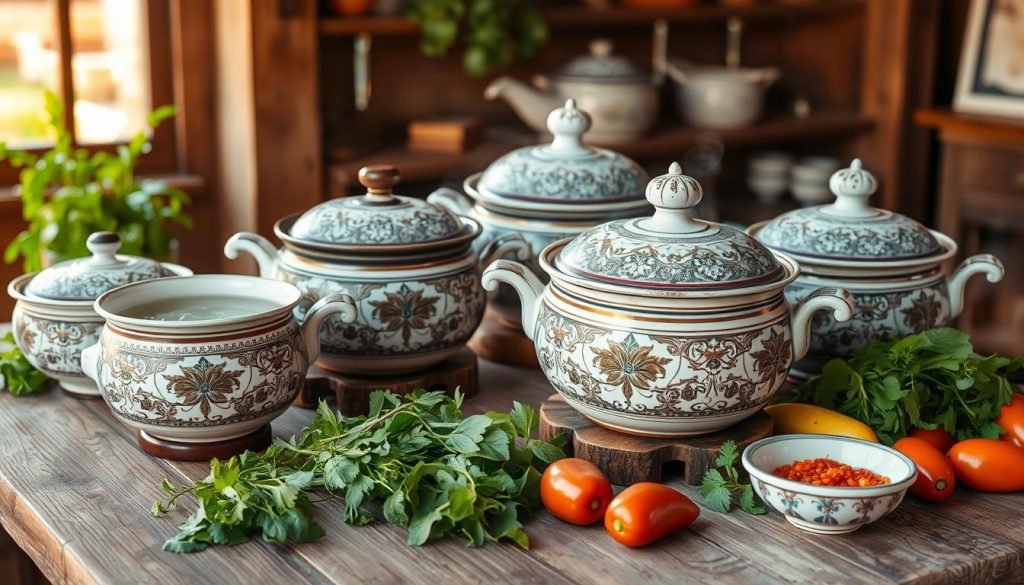The Art of Poaching

Have you ever wondered about the secret behind those perfect dishes by top chefs? Those that are gentle yet flavorful. It’s often due to poaching, an ancient cooking method. Many chefs love it for bringing out the best in food. But what makes poaching so special, and what are its secrets?
Key Takeaways
- Ideal temperature range for poaching liquids: 160°F to 180°F (71°C to 82°C).
- Poaching requires minimal or no added fats, making it a healthier cooking method.
- Cooking times vary: chicken breasts (15-20 minutes), fish fillets (8-10 minutes), whole eggs (3-4 minutes).
- Poached foods are known for their delicate, moist texture and enhanced mouthfeel.
- Common poaching liquids include water and broth, with regional herbs to enhance flavor.
What is Poaching in Culinary Terms?
Poaching is a delicate way to cook. It uses warm liquid to cook food without boiling or baking. This method is all about soft heat and keeping flavors in. Let’s learn what poaching really means, its history, and what foods are best for it.
Definition and Overview
Poaching cooks food in liquid at 160 to 180 degrees Fahrenheit. It’s great for keeping the food’s true taste and softness. This method works well for fish, chicken, eggs, veggies, and fruits. It cooks food gently and evenly.
History of Poaching Techniques
Ancient cultures started poaching techniques. French cuisine has really made it an art. Dishes like poached salmon and eggs benedict show how classic poaching is. Through time, poaching has kept changing to include new tastes but always stayed gentle.
Common Ingredients for Poaching
Certain foods are perfect for poaching. They include:
- Fruits: Desserts often feature poached pears, apples, and stone fruits.
- Fish: Delicate fish like salmon, cod, and sole are usually poached.
- Poultry: Chicken becomes tender and juicy through poaching.
- Eggs: Poached eggs are essential for breakfast and brunch.
- Vegetables: Poaching keeps asparagus and leeks tasting fresh.
The liquid for poaching can be water, broth, or wine. Adding onion, celery, and carrot enhances taste. The liquid should be 2 to 3 inches deep for the best flavor.
Keeping an eye on the temperature is key to poaching. Use a thermometer. For example, poached chicken must reach 160°F inside to be perfect.
Benefits of Poaching Foods
Poaching is a popular way to cook that has many health perks. It keeps the food’s nutrients and enhances its taste. Let’s dive into these benefits.
Health Benefits Compared to Other Cooking Methods
Poaching is great because it’s a low-fat way to cook. You don’t need to add extra oil or fat, which helps you eat healthier. It uses a gentle heat between 160°F to 180°F. This keeps the food’s quality without needing high heat.
Retaining Nutritional Value
Poaching is top-notch in keeping the food’s vitamins and minerals. It cooks food at about 200°F, so important nutrients aren’t lost. For instance, cooking fish at 155°F makes it moist and keeps its goodness. This also applies to poaching veggies and fruits, keeping them full of nutrients.
Flavor Enhancement Through Poaching
Poaching does wonders for flavor too. You can poach in broth, wine, or spiced wine for extra taste. For eggs, just a bit of vinegar in the water sets the whites and adds a light zing. Shallow poaching makes sauces and broths even more delicious.

| Cooking Method | Temperature Range (°F) | Optimal Cooking Time | Health Benefits |
|---|---|---|---|
| Poaching Eggs | 160°F – 180°F | 3-5 minutes | Low-Fat |
| Poaching Fish | 200°F | 8-10 minutes | Retains Nutrients |
| Poaching Fruits | 160°F – 180°F | 15-20 minutes | Preserves Vitamins |
Essential Equipment for Poaching
Having the right tools is crucial for poaching. It’s essential whether you’re making a soft poached egg or a tender piece of fish. Here’s a list of kitchen tools you’ll need to become a poaching expert.
Poaching Pots and Equipment
A poaching pot is key for this cooking method. These poaching pots are wide, shallow, and heat evenly. Look for one with a tight lid and a non-stick surface. A poaching insert can also keep food under water for even cooking.

Thermometers and Timers
Thermometers and timers are essential equipment. A digital thermometer helps keep the temperature perfect. For fish, aim for 175°F to 185°F. For chicken and beef, target 160°F to 175°F. Use timers to avoid overcooking. Fish usually takes about 10 minutes, and chicken needs 15-20 minutes.
Alternative Kitchen Tools
Other kitchen tools can also help with poaching. Use a spider strainer or slotted spoon for easy retrieval of poached items. A measuring jug ensures the right mix of water, stock, and acid. Each tool plays a crucial role in perfecting poaching.
| Item | Description | Recommended Temperature | Standard Cooking Time |
|---|---|---|---|
| Poaching Pot | Wide and shallow with a good lid | – | – |
| Digital Thermometer | Measures accurate poaching temperatures | 160°F – 185°F | – |
| Timer | Keeps track of cooking time | – | 10 – 20 minutes |
| Spider Strainer | Retrieves poached items gently | – | – |
| Measuring Jug | Prepares poaching liquid with accurate proportions | – | – |
Techniques for Poaching Different Foods
Mastering the art of poaching foods can make them taste amazing. It helps keep the food soft and flavorful. We’re going to learn how to poach eggs, fish, and fruits.
Poaching Eggs with Precision
Getting eggs poached right is an art. It needs a temp between 160°F and 165°F. At this temp, the whites get soft but firm, and the yolks stay runny.
Use a shallow pan with a bit of vinegar in the water. Heat it to the right temp. Put the egg in a bowl, then slide it into the water. Cook for 3-4 minutes until the whites set. Use a slotted spoon to take it out.

Poaching Fish to Perfection
Poaching keeps fish tasting light and tender. The perfect temp is between 160°F and 170°F. Make a court bouillon with water, wine, herbs, and aromatics for poaching liquid.
Slowly put the fish in and cook for 8-10 minutes, depending on thickness. The fish should be opaque and easy to flake with a fork.
Poaching Fruits for Desserts
Poached fruits make desserts extra sweet. The best temp for fruits is from 160°F to 175°F. Create a syrup with water, sugar, and your chosen spices or herbs.
Add fruits like pears or apples, and simmer gently. Cook them for 15-20 minutes until they’re soft. This makes a flavorful dessert that’s good warm or cold.
| Food | Temperature Range (°F) | Cooking Time |
|---|---|---|
| Fish Fillets | 160°F to 170°F | 8-10 minutes |
| Chicken Breasts | 170°F to 180°F | 15-20 minutes |
| Whole Eggs | 160°F to 165°F | 3-4 minutes |
| Pears | 160°F to 175°F | 15-20 minutes |
Mastering the Poaching Process
Poaching is a fine cooking art. It’s all about preparing things nicely, making the best liquid, and using the correct heat. Let’s learn how to make poaching work perfectly every time.
Preparing Ingredients for Poaching
First, get your ingredients ready for mastering poaching. Use fresh eggs because they have better whites that stay together. For fish, freshness and using great fish sauce can make dishes taste amazing.
Here are some tips for getting ready to poach:
- Fresh eggs: Make sure they are fresh to keep their shape well.
- Water depth: Use 3-4 inches of water for eggs.
- Add vinegar: A spoon of vinegar makes egg whites set quicker.
- Quality fish sauce: Pick top-notch fish sauce for delicious broth.
Creating the Ideal Poaching Liquid
Making the ideal poaching liquid needs the right balance. Choose good ingredients for a tasty broth. To prepare pho broth, first boil beef and bones for 10 minutes, then clean them. Boil again in new water for up to 4 hours.

- SENSARTE Nonstick Sauce Pan: It shares heat well and prevents sticking.
- Wide, shallow pan: Good for poaching more than one egg at once.
Setting the Right Temperature
Keeping the right temperature is crucial. A soft simmer stops overcooking and keeps eggs and fish just right. For eggs with soft yolks, cook 3-4 minutes. Fish takes a few minutes, depending on its size.
Important temperature tips:
- Simmering time: Keep a soft simmer to not overcook.
- Egg poaching time: 3-4 minutes for soft yolk; adjust for your taste.
With these tips on preparing ingredients, making the best poaching liquid, and keeping the right heat, you’re ready to master poaching.
| Ingredient | Preparation Time | Poaching Time |
|---|---|---|
| Eggs | 1 minute | 3-4 minutes |
| Fish | 2 minutes | 3-5 minutes |
| Pho Broth | 10 minutes (blanching) | 4 hours |
Popular Poached Dishes Around the World
Exploring poached dishes is a fun journey through different foods. Poaching gently cooks food and keeps flavors fresh. It is used all over the world, from French classics to Asian dishes and new ideas.
Classic French Poached Dishes
France loves using poaching in cooking. Oeufs en Meurette are poached eggs in a red wine sauce. They come with bacon, mushrooms, and onions. Another favorite is Blanquette de Veau, a veal stew in white sauce. These dishes show how poaching can make food sophisticated and tasty.
Asian Influences in Poaching
In Asia, poaching is also popular with unique flavors. Japan’s Shabu-Shabu is thinly sliced meat quickly poached. It’s dipped in different sauces. And in China, Hainanese Chicken Rice has poached chicken with fragrant rice. These dishes highlight poaching’s wide use in Asia.

Modern Takes on Traditional Poached Foods
Chefs today are getting creative with poaching. They use new ingredients and presentations. For example, poached oysters can come from places like Miyagi or Maine. They are poached in white wine or seafood stock for 2-3 minutes. This shows how chefs mix old methods with new flavors. Another new method is poaching eggs with a “vortex” technique, adding things like vinegar for the perfect texture.
- Fresh eggs work best.
- Egg poaching temperatures should be between 180°F and just below boiling.
- Oysters should be poached for 2–3 minutes.
- Use poaching liquids again for eco-friendly cooking.
Poaching is still loved for keeping foods’ natural tastes. It goes from French dishes to Asian styles and modern twists. This cooking method is a favorite in kitchens everywhere.
Common Mistakes in Poaching
Poaching needs careful attention to get it right. Mistakes like overcooking or choosing the wrong poaching liquid can mess up the dish. Knowing these errors and how to dodge them helps you perfect poaching.

Overcooking and How to Avoid It
Overcooking is a big mistake when poaching. It’s important to watch the time and heat closely. For eggs, poach at a simmer—about 195°F. This prevents them from turning rubbery. Use a timer for 3 to 4 minutes to get them just right.
Boiling too hard puts eggs at risk of overcooking. A gentle simmer cooks them evenly. If you like runny yolks, take the eggs out after 2.5 minutes. Then cool them fast in ice water.
Choosing the Wrong Poaching Liquid
Another hiccup is picking a bad poaching liquid. The right one adds flavor and keeps the food intact. To help egg whites stay firm, mix 1-2 tablespoons of vinegar into your water.
Don’t salt the water before poaching; it makes food rubbery. Season the eggs after they’re cooked. Using fresh eggs helps their whites stay close, making a perfect poach easier.
Inadequate Temperature Control
Not controlling the temperature right is a common issue. A thermometer can keep the water just right. Eggs do best at a steady 195°F. This avoids both under and overcooking.
Here’s a handy table that sums up how to steer clear of poaching pitfalls:
| Common Mistake | Solution |
|---|---|
| Overcooking | Simmer at around 195°F, use a timer (3-4 minutes), ice bath after poaching |
| Wrong Poaching Liquid | Add 1-2 tablespoons of vinegar, avoid salting water, season after cooking |
| Inadequate Temperature Control | Use a thermometer, maintain steady temperature |
By avoiding these common mistakes and focusing on details like not overcooking and picking the right poaching liquid, your poached dishes will always impress.
Tips for Perfecting Your Poaching Skills
Learning how to poach can elevate your cooking to a whole new level. To help you along the way, here are some invaluable tips that integrate perfectly into your culinary routine.
Experimenting with Flavors
One of the best ways to master poaching is by experimenting with different flavors. Infusing your poaching liquid with herbs, wine, or aromatic vegetables can dramatically enhance the taste of your dish. For example, adding a splash of vinegar not only enhances flavor but also assists in quicker coagulation of egg whites, making for a perfect poach.

Practicing Consistent Timing
Consistent timing is crucial to perfecting poaching skills. For instance, the recommended poaching time for a large egg cold from the fridge is between 3 to 5 minutes. Keeping this timing consistent ensures that the whites are set while the yolk remains runny.
Practicing these specific timings for various types of eggs can make a huge difference:
- Soft-Boiled: 4-6 minutes
- Medium-Boiled: 8-9 minutes
- Hard-Boiled: 12-14 minutes
- Scrambled: 3-4 minutes
Learning from Kitchen Experts
Gaining insights from culinary experts like Julia Child can significantly improve your poaching technique. Julia recommends simmering less fresh eggs in their shells for 8 to 10 seconds before poaching. This ensures the eggs hold their shape better during poaching. Additionally, she emphasizes achieving the ideal water temperature, which is just below boiling, approximately 190°F to 200°F (88°C to 93°C).
Renowned chef Sarah Rose describes Julia’s technique as a genius solution, perfect for anyone striving to perfect their poaching skills. Following these expert tips can lead to achieving consistently perfect results every time you poach.
The Future of Poaching in Culinary Art
The culinary world keeps changing, bringing in new trends. This includes better ways to poach food. Now, smart kitchen tools are more common in homes and pro kitchens. This change shows a big shift in cooking styles. The global market for these smart tools could hit USD 62 billion by 2025. This shows how important these gadgets are for making cooking easier. Also, more than 68% of people cooking at home now get their recipes online. They prefer this over old cookbooks.
Trends and Innovations in Poaching Techniques
New poaching methods are changing how cooks do things. Sous vide cooking is getting popular. It cooks food in water at just the right temperature. This method has become a favorite for 40% of chefs in the past ten years. Also, smart kitchen tools are improving, growing by 15.5% every year. They help make poaching more accurate. Connected kitchen gadgets also play a big part. They make cooking faster by up to 40% and ensure the food comes out just right.
Sustainability and Poaching Practices
Being eco-friendly in cooking is getting more attention, and poaching leads the way. Smart fridges can cut food waste by 30%. They’re part of a bigger move towards better food management. Poaching is good because it keeps more nutrients than dry cooking. More people want cooking methods that are good for the planet. Poaching is great for making tasty, healthy food with little energy or resource use.
The Evolution of Poached Dishes in Modern Cuisine
Modern cuisine is seeing a lot of changes, with a focus on health and new flavors. Websites like Allrecipes bring lots of ideas for poached dishes. They have over 50 million visitors a month. E-books on cooking are also popular, making up 25% of all book sales. They make it easy to learn new poaching methods and recipes. Chefs are trying out new flavors and presentations. They even use 3D food printing, expected to grow a lot by 2026. This mix of old techniques and new tech keeps poaching exciting in cooking. Additionally, home cooks are increasingly exploring diverse cooking methods, including smoking techniques for beginners, which adds a unique depth of flavor to various dishes. Online tutorials and cooking classes have made these techniques accessible, encouraging more people to experiment in their own kitchens. As culinary boundaries continue to blur, the fusion of traditional cooking methods with innovative approaches is reshaping the culinary landscape in exciting ways.